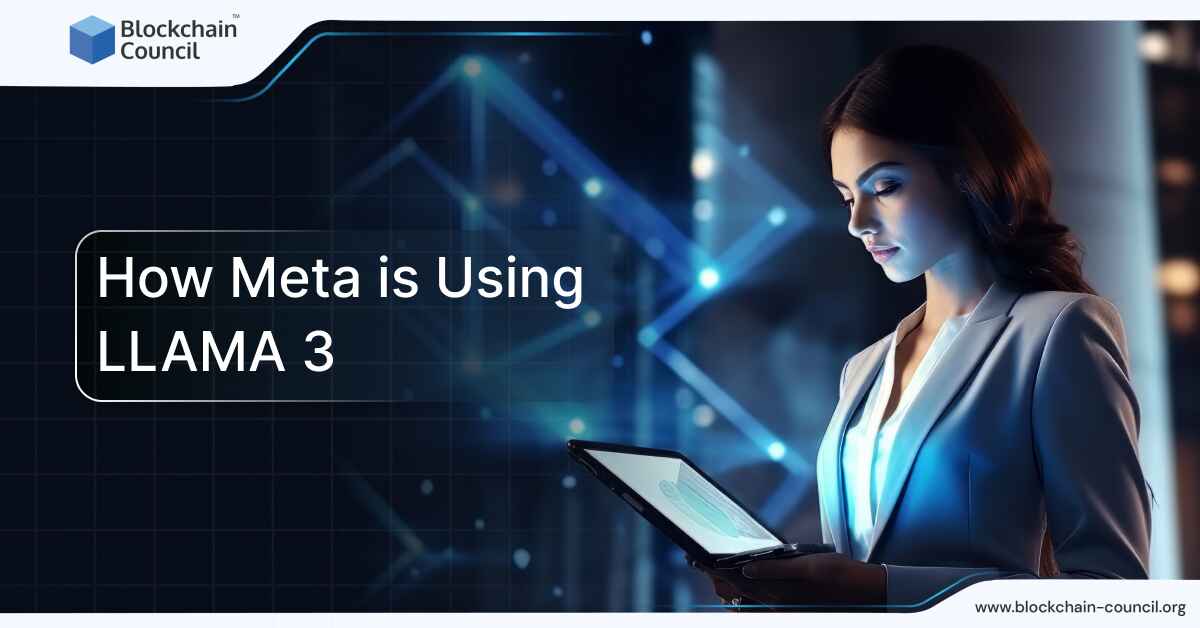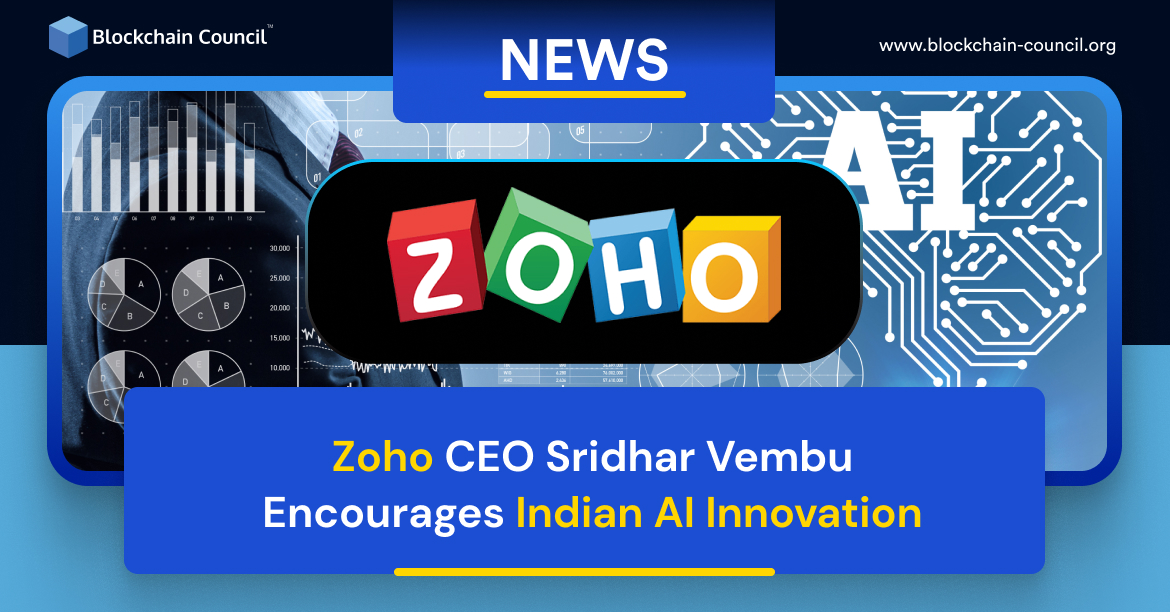
- Blockchain Council
- August 22, 2024
Meta is making headlines again with LLAMA 3, the latest version of its open-source AI model. But instead of keeping it behind closed doors, Meta is putting LLAMA 3 to work across all its products. But how? The bigger question is, why LLAMA 3? Let’s find out!
What is LLAMA 3?
LLAMA 3 is the latest iteration of Meta’s large language model (LLM) series. Unlike its predecessors, LLAMA 3 was trained on an enormous dataset of over 15 trillion tokens, a significant increase from the 1.8 trillion tokens used for LLAMA 2. This extensive training allows LLAMA 3 to perform more complex tasks, including text processing, image generation, and code execution, with improved accuracy and speed.
Released on April 18, 2024, the model also features an expanded vocabulary and enhanced reasoning capabilities, making it one of the most versatile and powerful open-source models available today. LLAMA 3.1 is Meta’s latest large language model (LLM), released in July 2024, as part of its open-source AI initiative. This model is an upgrade from the earlier LLAMA versions, designed to push the boundaries of what open-source AI can achieve. To know more about LLAMA 3, read our article here.
How is Meta Integrating LLAMA 3 Across Its Platforms?
Meta has integrated LLAMA 3 across all its platforms. Here’s how:
Enhanced AI Assistant Across Apps
Meta has significantly upgraded its AI assistant using LLAMA 3. This assistant, available on Facebook, Instagram, WhatsApp, and Messenger, provides smarter and faster responses. It helps with tasks like finding real-time information, recommending activities, or generating creative content. This AI is now accessible in more countries, offering users around the world improved interaction experiences.
Open-Source Innovation
Meta has taken a bold step by making LLAMA 3.1, its latest language model, open-source. This model, boasting 405 billion parameters, is one of the largest and most powerful available. It supports multiple languages and offers advanced capabilities in tasks like reasoning, math, and coding. Developers and businesses can use LLAMA 3.1 to build their own AI-driven applications, marking a significant shift towards open AI development.
Integration in AI Studio
Meta has also integrated LLAMA 3 into AI Studio, a platform that allows users to create custom AI personas. This feature gives creators the ability to build AI tools that reflect their personal brand, enabling deeper engagement with their audience. It’s a move that empowers users to tailor their AI experience across Meta’s ecosystem.
Why is Meta Integrating LLAMA 3 Across Its Platforms?
Meta is using LLAMA 3 and 3.1 for several key reasons, all aligned with its strategic goals of innovation, accessibility, and competition in the AI space. Here’s the AI strategy behind this decision:
1. Open-Source Commitment
Meta is deeply invested in the open-source philosophy, which it believes accelerates innovation by allowing a broad community of developers to contribute to and improve AI models. By releasing LLAMA 3 and 3.1 as open-source, Meta aims to foster a collaborative environment where anyone can refine, customize, and use these models. This approach helps avoid the constraints of closed systems and encourages diverse applications across industries.
2. Advanced Capabilities
LLAMA 3.1, especially the 405B model, is designed to compete directly with leading AI models like GPT-4. It has been trained on vast amounts of data (15 trillion tokens) and is optimized for various tasks, including multilingual translation, coding, and general knowledge tasks. The model’s expanded context length (up to 128,000 tokens) allows it to handle more complex inputs, making it highly effective for applications like long-form text summarization and interactive chatbots.
3. Strategic Integration and Partnerships
Meta integrates LLAMA 3 models across its platforms, such as WhatsApp and Meta.ai, to enhance user experiences with AI-driven features. Additionally, Meta collaborates with industry giants like AWS, Google Cloud, and Nvidia to ensure that LLAMA models are easily accessible and scalable across different environments. This integration not only improves Meta’s product offerings but also strengthens its position in the competitive AI landscape.
4. Scalability and Future Focus
Meta has heavily invested in the infrastructure needed to support the development and deployment of LLAMA 3 models. The company optimized its training processes using thousands of GPUs, ensuring that these models are both powerful and scalable. Meta’s ongoing commitment to expanding its AI capabilities, including plans for future models like LLAMA 4, demonstrates its focus on staying at the forefront of AI innovation.
How to Master LLAMA 3 and Land a Job at Meta
To land a job at Meta and work with advanced AI technologies like Llama 3, enrolling in Blockchain Council’s AI certifications could be a smart move. Meta’s latest Llama 3.1, with its 405 billion parameters, is a cutting-edge AI model that rivals some of the best in the industry. To work with such advanced models, you need solid AI expertise. Blockchain Council offers certifications like Certified Artificial Intelligence Expert™ and Certified Generative AI Expert™, which equip you with crucial skills in AI, machine learning, and NLP (Natural Language Processing). These certifications and the Master Artificial Intelligence (AI) learning path focus on practical, job-ready skills, making you an attractive candidate for AI roles at companies like Meta.
Moreover, Blockchain Council’s certifications are designed with input from industry experts, ensuring that you learn what’s relevant and needed in today’s tech landscape. As Meta continues to push boundaries with open-source AI models like Llama 3.1, having these certifications on your resume could set you apart, showing employers that you have both the knowledge and the initiative to excel in this rapidly evolving field.
Conclusion
Meta’s use of LLAMA 3 goes beyond the typical applications of AI. By integrating it into different areas, Meta is setting the stage for significant shifts in how we interact with technology every day. As LLAMA 3 continues to be developed and applied, it’s clear that Meta’s strategy could have lasting effects on the tech landscape and beyond. Keep an eye on this—it’s a development that could impact more than just the AI community.
Wondering how to make the most of such AI models? Enroll into expert-curated AI certifications like the Certified Prompt Engineer™ and make sure no bit of AI can escape your pro hands!
FAQs
How is LLAMA 3 being used across Meta’s platforms?
- Integrated into Meta’s AI assistant for smarter, faster responses on Facebook, Instagram, WhatsApp, and Messenger.
- Supports custom AI personas through AI Studio for tailored user experiences.
- Enhances real-time information retrieval, content creation, and multilingual capabilities across Meta apps.
What makes LLAMA 3 different from previous versions?
- Trained on 15 trillion tokens, significantly more than LLAMA 2.
- Features enhanced reasoning, expanded vocabulary, and improved task performance.
- Offers longer context handling (up to 128,000 tokens) for complex tasks like long-form text summarization.
Why did Meta make LLAMA 3 open-source?
- To foster innovation by allowing developers worldwide to refine, customize, and use the model.
- Encourages diverse applications and contributions from the broader AI community.
- Aligns with Meta’s commitment to openness and competition in the AI space.
What challenges does LLAMA 3 face and how is Meta addressing them?
- Scalability: Meta could develop smaller, distilled versions for broader accessibility.
- Memory Management: Optimization techniques like sparse attention could improve efficiency.
- Data Bias: Continuous monitoring and diverse data inclusion aim to mitigate biases.
- Ethical Concerns: Tools like Llama Guard 3 ensure responsible AI use, with ongoing updates and community engagement.





































































 Guides
Guides News
News Blockchain
Blockchain Cryptocurrency
& Digital Assets
Cryptocurrency
& Digital Assets Web3
Web3 Metaverse & NFTs
Metaverse & NFTs
